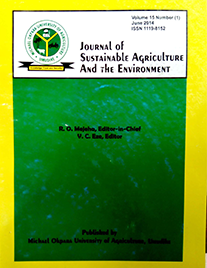A Comparative Growth and Economic Performance of Broiler Chicks Fed Pelletized and Non-Pelletized Feed in a Humid Tropical Environment
Main Article Content
Abstract
The study was designed to evaluate the economic performance of birds fed 100% pelletized, 100% reground pelletized, and a combination of 50% pelletized and 50% reground pelletized feed. A total of one hundred and fifty day old broiler chicks were used for the study. There were three treatments of fifty birds each and five replicates of ten birds each per treatment. The first group of treatment one (T1) were fed 100% pelletized feed. Those of treatment two (T2) were fed 100% reground pelletized feed, while those of treatment three (T3) were fed a combination of 50% pelletized and 50% reground pelletized feed. Data collected were the feed intake, live weight, overall weight gain, daily weight gain, feed conversion ratio, and feed cost per weight gain and gross margin. The results showed significant (P<0.05) differences in the weight gain, feed conversion ratio, live weight, feed cost per weight gain, revenue and gross margin. Birds fed pelletized feed had significantly higher mean weight gain and daily weight gain compared to other treatment groups. Feed conversion ratio was highest while revenue was lowest for broilers fed 100% reground pelletized feed. This group also had the least gross margin compared to other groups (N763.85 Vs N1190.41 Vs N1327.28 for T2 Vs T3 Vs T1). The study recommends 100% pelletized feed for broiler production.
(Keywords: Growth performance, gross margin, Pelletized feed, non-pelletized feed, broiler)
Article Details
References
Gadzirayi, C.T., Mutandwa, E., Chihiya, J. and Mlambo, R. (2006): A comparative economic analysis of mash and pelleted feed in broiler production under deep litter housing system. Inter. J. of Poultry Sci. 5 (7): 629 – 631.
Hussar, N. and Robblee, A.R. (1962): Effect of pelleting on the utilization of feed by the growing chicken. Poultry Sci. 41: 1489.
Mutetwa, L. (2001): Irvin’s National Foods and ZIMVET Newsletter Vol 8, Number 2.
Nkomo, N. (2001): Irvin’s National Foods and ZIMVET Newsletter, Vol 8, No2.
Nyoupayou, J.D.N. (1990): Country Report of Small Rural International on Rural Poultry Production. Thessalonic. Greece.
Schoeff, R.W. (1994): History of the formula Feed Industry. In: R.R. McEllhiney, Ed. Feed Manufacturing Technology 1V. American Feed Industry Association. Arlington, Virginia: 7.
Steel, R.G.D. and Torrie, J.H. (1980): Principles and procedures of statistics. A Biometrical Approach. 2nd ed. McGraw Hill Book Co. Inc., NewYork, 633 pages.

